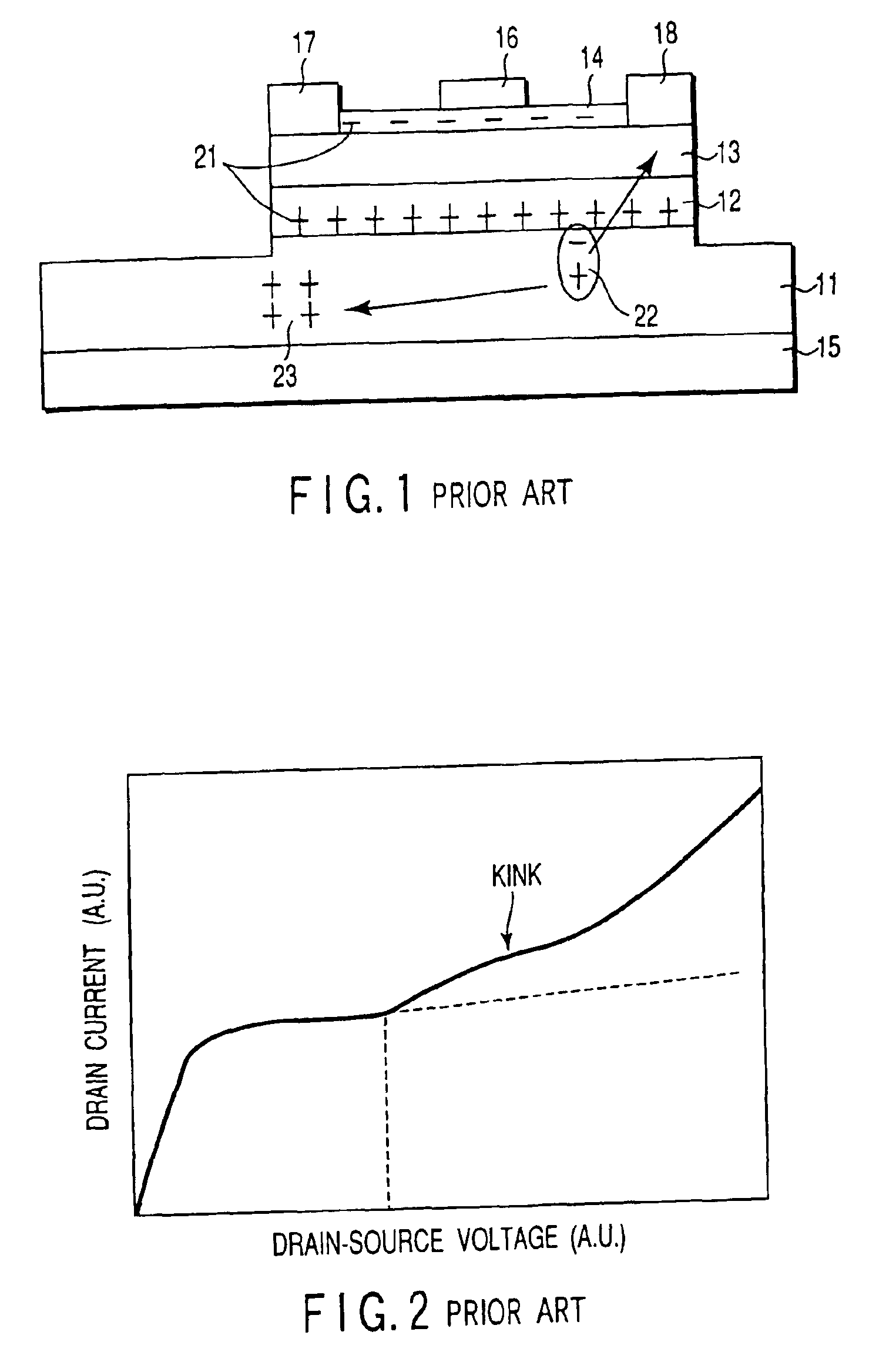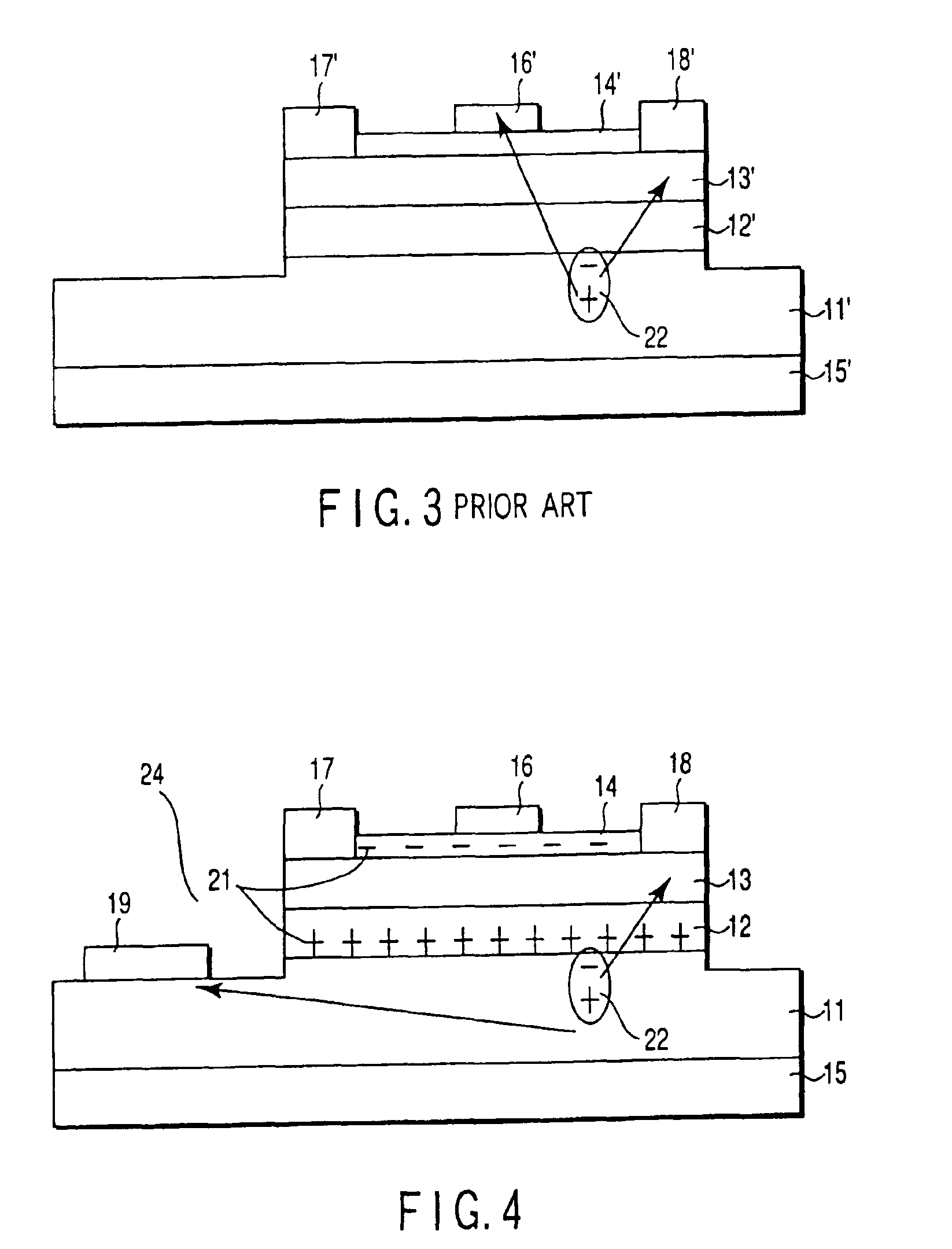High electron mobility transistor and method of manufacturing the same
a high-electromagnetic transistor and electron mobility technology, applied in the direction of basic electric elements, electrical apparatus, semiconductor devices, etc., can solve the problems of linearity deterioration, distortion, and sometimes kink phenomenon in drain-current/voltage characteristics, and achieve the effect of high electron mobility and preventing kink phenomenon
- Summary
- Abstract
- Description
- Claims
- Application Information
AI Technical Summary
Benefits of technology
Problems solved by technology
Method used
Image
Examples
first embodiment
[0044](First Embodiment)
[0045]FIG. 4 is a schematic cross-sectional view of a high electron mobility transistor (HEMT) according to a first embodiment of the present invention. Reference numerals 11, 12, 13, 14 and 15 denote a GaN electron accumulation layer, Alx Ga(1-x)N spacer layer, n-type AlxGa(1-x)N electron supply layer, AlxGa(1-x)N cap layer, and sapphire substrate, respectively. A gate electrode 16 is formed on the cap layer 14, while a source electrode 17 and a drain electrode 18 are formed on the electron supply layer 13. Furthermore, a hole absorption electrode 19 is formed for absorbing holes in a recess portion 24. The recess portion 24 is formed for isolation by removing a peripheral portion, other than an element region, of layers 12, 13 and 14 to reach the electron accumulation layer 11.
[0046]A manufacturing method of the HEMT of the first embodiment is described below. The undoped GaN electron accumulation layer 11 of 2 μm thick is grown on the (0001) sapphire subst...
second embodiment
[0054](Second Embodiment)
[0055]FIG. 5 is a schematic cross-sectional view of a high electron mobility transistor according to a second embodiment of the present invention. The feature of the second embodiment resides in that a p-type semiconductor layer 20 (e.g., p-type GaN layer), or a semiconductor layer having a smaller bandgap width than that of the electron accumulation layer 11 is formed on the undoped GaN electron accumulation layer 11, and thereafter, a hole absorption electrode 19 is formed on the semiconductor layer 20. In this manner, it is possible to absorb holes more effectively than in the first embodiment. In FIG. 5, like reference numerals are used to designate like structural elements corresponding to those in FIG. 4 (the first example) and any further explanation is omitted for brevity's sake.
third embodiment
[0056](Third Embodiment)
[0057]FIG. 6 is a schematic top view of a high electron mobility transistor according to a third embodiment of the present invention. The first HEMT electrodes are formed of a gate electrode 16-1, a source electrode 17-1, and a drain electrode 18-1. The second HEMT electrodes are formed of a gate electrode 16-2, a source electrode 17-2, and a drain electrode 18-2. The feature of the third embodiment resides in that the hole absorption electrode 19 is formed in parallel with the gate electrode 16-1 in the gate width direction and has substantially the same length as the source electrode 17-1 in the gate width direction. Since the length of the hole absorption electrode 19 is the same as that of the source electrode 17-1, the effect of the hole absorption can be made uniform at any cross section of the drain current direction within the FET, and the kink phenomenon is most effectively suppressed compared to the case where the hole absorption electrode is shorte...
PUM
 Login to View More
Login to View More Abstract
Description
Claims
Application Information
 Login to View More
Login to View More - R&D
- Intellectual Property
- Life Sciences
- Materials
- Tech Scout
- Unparalleled Data Quality
- Higher Quality Content
- 60% Fewer Hallucinations
Browse by: Latest US Patents, China's latest patents, Technical Efficacy Thesaurus, Application Domain, Technology Topic, Popular Technical Reports.
© 2025 PatSnap. All rights reserved.Legal|Privacy policy|Modern Slavery Act Transparency Statement|Sitemap|About US| Contact US: help@patsnap.com



